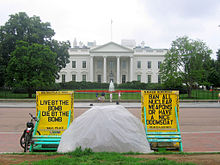Barricade at the Paris Commune, March 1871
Civil rights activists at the March on Washington for Jobs and Freedom during the civil rights movement in August 1963
A women's liberation march in Washington, D.C., August 1970
Activism consists of efforts to promote, impede, direct, or intervene in social, political, economic, or environmental reform with the desire to make changes in society. Forms of activism range from mandate building in the community (including writing letters to newspapers), petitioning elected officials, running or contributing to a political campaign, preferential patronage (or boycott) of businesses, and demonstrative forms of activism like rallies, street marches, strikes, sit-ins, or hunger strikes.
Activism may be performed on a day-to-day basis in a wide variety of ways, including through the creation of art (artivism), computer hacking (hacktivism), or simply in how one chooses to spend their money (economic activism). For example, the refusal to buy clothes or other merchandise from a company as a protest against the exploitation of workers
by that company could be considered an expression of activism. However,
the most highly visible and impactful activism often comes in the form
of collective action, in which numerous individuals coordinate an act of protest together in order to make a bigger impact. Collective action that is purposeful, organized, and sustained over a period of time becomes known as a social movement.
Historically, activists have used literature, including
pamphlets, tracts, and books to disseminate or propagate their messages
and attempt to persuade their readers of the justice of their cause. Research has now begun to explore how contemporary activist groups use social media to facilitate civic engagement and collective action combining politics with technology.
Definitions of activism
The Online Etymology Dictionary records the English words "activism" and "activist" as in use in the political sense from the year 1920 or 1915 respectively. The history of the word activism traces back to earlier understandings of collective behavior and social action. As late as 1969 activism was
defined as "the policy or practice of doing things with decision and
energy", without regard to a political signification, whereas social action was
defined as "organized action taken by a group to improve social
conditions", without regard to normative status. Following the surge of
so-called "new social movements" in the United States in the 1960s, a
new understanding of activism emerged as a rational and acceptable democratic option of protest or appeal. However, the history of the existence of revolt through organized or unified protest in recorded history dates back to the slave revolts of the 1st century BC(E) in the Roman Empire, where under the leadership of former gladiator Spartacus 6,000 slaves rebelled and were crucified from Capua to Rome in what became known as the Third Servile War.
In English history, the Peasants' Revolt erupted in response to the imposition of a poll tax, and has been paralleled by other rebellions and revolutions in Hungary, Russia, and more recently, for example, Hong Kong. In 1930 under the leadership of Mahatma Gandhi thousands of protesting Indians participated in the Salt March,
as a protest against the oppressive taxes of their government,
resulting in the imprisonment of 60,000 people and eventually
independence of their nation. In nations throughout Asia, Africa and
South America, the prominence of activism organized by social movements and especially under the leadership of civil activists or social revolutionaries
has pushed for increasing national self-reliance or, in some parts of
the developing world, collectivist communist or socialist organization
and affiliation.
Activism has had major impacts on Western societies as well,
particularly over the past century through social movements such as the Labour movement, the Women's Rights movement, and the civil rights movement.
Types of activism
Activists
can function in a number of roles, including judicial, environmental,
internet (technological) and design(art). Historically, most activism
has focused on creating substantive changes in the policy or practice of
a government or industry. Some activists try to persuade people to
change their behavior directly (see also direct action), rather than to persuade governments to change laws. For example, the cooperative movement
seeks to build new institutions which conform to cooperative
principles, and generally does not lobby or protest politically. Other
activists try to persuade people or government policy to remain the
same, in an effort to counter change.
Activism is not an activity always performed by those who profess activism as a profession.
The term ″activist″ may apply broadly to anyone who engages in
activism, or narrowly limited to those who choose political or social
activism as a vocation or characteristic practice.
Judicial and citizen activism
Judicial activism involves the efforts of public officials. Arthur Schlesinger, Jr. - American historian, public intellectual, and social critic - introduced the term "judicial activism" in a January 1946 Fortune magazine article titled "The Supreme Court: 1947". Activists can also be public watchdogs and whistle blowers,
attempting to understand all the actions of every form of government
that acts in the name of the people and hold it accountable to oversight
and transparency. Activism involves an engaged citizenry.
Environmental activism
Environmental activism takes quite a few forms:
- the protection of nature or the natural environment driven by a utilitarian conservation ethic or a nature oriented preservationist ethic
- the protection of the human environment (by pollution prevention or the protection of cultural heritage or quality of life)
- the conservation of depletable natural resources
- the protection of the function of critical earth system elements or processes such as the climate.
Internet activism
The power of Internet activism came into a global lens with the Arab Spring
protests starting in late 2010. People living in the Middle East and
North African countries that were experiencing revolutions used social
networking to communicate information about protests, including videos
recorded on smart phones, which put the issues in front of an
international audience.
This was the one of the first occasions in which social networking
technology was used by citizen-activists to circumvent state-controlled
media and communicate directly with the rest of the world. These types
of practices of Internet activism were later picked up and used by other
activists in subsequent mass mobilizations, such as the 15-M Movement in Spain in 2011, Occupy Gezi in Turkey in 2013, and more.
Internet activism may also refer to activism which focuses on protecting or changing the Internet itself, also known as digital rights. The Digital Rights movement consists of activists and organizations, such as the Electronic Frontier Foundation, who work to protect the rights of people in relation to new technologies, particularly concerning the Internet and other information and communications technologies.
Activism in literature
Activism in literature (not to be confused with literary activism)
includes the expression of intended or advocated reforms, realized or
unachieved, through published, written or verbally promoted or
communicated forms.
Economic activism
Economic activism involves using the economic power of government, consumers, and businesses for social and economic policy change.
Both conservative and liberal groups use economic activism to as a form
of pressure to influence companies and organizations to oppose or
support particular political, religious, or social values and behaviors. This is typically done either through preferential patronage to reinforce "good" behavior and support companies one would like to succeed, or through boycott or divestment to penalize "bad" behavior and pressure companies to change or go out of business.
Consumer activism consists of activism carried out on behalf of consumers for consumer protection or by consumers themselves. For instance, activists in the free produce movement of the late 1700s protested against slavery by boycotting goods produced with slave labor. Today, vegetarianism, veganism, and freeganism are all forms of consumer activism which boycott certain types of products. Other examples of consumer activism include simple living, a minimalist lifestyle intended to reduce materialism and conspicuous consumption, and tax resistance, a form of direct action and civil disobedience in opposition to the government that is imposing the tax, to government policy, or as opposition to taxation in itself.
Shareholder activism involves shareholders using an equity stake in a corporation to put pressure on its management. The goals of activist shareholders range from financial (increase of shareholder value through changes in corporate policy, financing structure, cost cutting, etc.) to non-financial (disinvestment from particular countries, adoption of environmentally friendly policies, etc.).
Visual Activism
Design
Activism locates design at the centre of promoting social change,
raising awareness on social/political issues, or questioning problems
associated with mass production and consumerism. Design Activism is not
limited to one type of design.
Art Activism or Artivism utilizes the medium of visual art as a method of social or political commentary.
Methods
The longest running peace vigil in U.S. history, started by activist Thomas in 1981.
Activists employ many different methods, or tactics, in pursuit of their goals.
Decisions over what tactics to use or not may be planned carefully in
advance, result from negotiations with law enforcement such as when and
where to hold a rally, or be made in the heat of the moment. The tactics
chosen are significant because they can determine how activists are
perceived and what they are capable of accomplishing. For example,
nonviolent tactics generally tend to garner more public sympathy than
violent ones and are more than twice as effective in achieving stated goals.
Charles Tilly developed the concept of a “repertoire of contention,” which describes the full range of tactics available to activists at a given time and place.
This repertoire consists of all of the tactics which have been proven
to be successful by activists in the past, such as boycotts, petitions,
marches, and sit-ins, and can be drawn upon by any new activists and
social movements. Activists may also innovate new tactics of protest.
These may be entirely novel, such as Douglas Schuler's idea of an
"activist road trip", or may occur in response to police oppression or countermovement resistance. New tactics then spread to others through a social process known as diffusion, and if successful, may become new additions to the activist repertoire.
Many contemporary activists now utilize new tactics through the Internet and other information and communication technologies (ICTs), also known as Internet activism
or cyber-activism. Some scholars argue that many of these new tactics
are digitally analogous to the traditional offline tools of contention. Other digital tactics may be entire new and unique, such as certain types of hacktivism. Together they form a new "digital repertoire of contention" alongside the existing offline one. The rising use of digital tools and platforms by activists has also increasingly led to the creation of decentralized networks of activists that are self-organized and leaderless, or what is known as franchise activism.
Common methods used for activism include:
- Community building
- Lobbying
- Media activism
- Peace activism
- Petition
- Political campaigning
- Propaganda
- Protest
- Strike action
Activism industry
Some
groups and organizations participate in activism to such an extent that
it can be considered as an industry. In these cases, activism is often
done full-time, as part of an organization's core business. Many organizations in the activism industry are either non-profit organizations or non-governmental organizations with specific aims and objectives in mind. Most activist organizations do not manufacture goods, but rather mobilized personnel to recruit funds and gain media coverage.
The term activism industry has often been used to refer to outsourced fundraising operations. However, activist organizations engage in other activities as well. Lobbying,
or the influencing of decisions made by government, is another activist
tactic. Many groups, including law firms, have designated staff
assigned specifically for lobbying purposes. In the United States,
lobbying is regulated by the federal government.
Many government systems encourage public support of non-profit organizations by granting various forms of tax relief for donations to charitable organizations. Governments may attempt to deny these benefits to activists by restricting the political activity of tax-exempt organizations.




